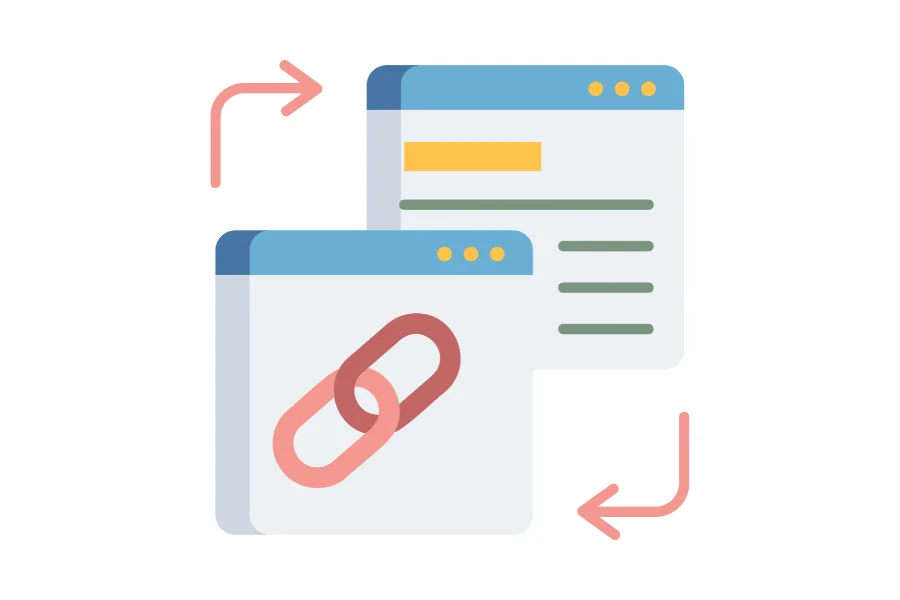In the world of search engine optimization (SEO), you should know the importance of backlinks are a major force behind a website’s authority, visibility, and ability to rank on Google.
Think of backlinks as endorsements; each backlink signals to search engines that other websites find your content valuable, trustworthy, and worth sharing.
But how exactly do backlinks work? And how can you build a strong, effective backlink profile that actually drives SEO success?
We’re breaking down everything you need to know: why backlinks matter, the qualities of high-value backlinks, and the best strategies to build them.
What is the Importance of Backlinks in SEO?
Let’s talk about the power of backlinks and why they’re crucial for getting your content seen.
Authority and Credibility
Backlinks essentially act as “votes” for your content. When a reputable website links to your page, it’s like that website is endorsing your content to Google.
This shows search engines that your page offers value, quality, and reliability, especially when the link comes from a site with a strong domain authority.
This credibility boost translates into higher rankings on search engine results pages (SERPs).
The more reputable sites that link to you, the more “trust” you gain in Google’s eyes. But it’s not just about numbers; high-quality backlinks from diverse, trustworthy domains are the real gold here.
💡 Pro Tip: Prioritize backlinks from high-authority sites and avoid spammy sources. Low-quality links can hurt your credibility and even result in penalties from Google.
Boosting Traffic and Discoverability
Backlinks aren’t just for search engines—they’re also a direct line for visitors to discover your site.
Every link is a potential traffic source, guiding people from one site to yours and increasing your overall visibility.
For example, a link from a popular blog or news site can introduce new readers to your content, attracting organic traffic beyond Google searches.
These new visitors could then share your content, potentially leading to even more backlinks.
Relevance Matters in SEO Backlinks
One thing to note: not all backlinks are equal in the eyes of search engines.
Links from websites in a similar industry or niche carry more weight than random links from unrelated sources.
Let’s say you run a fitness blog. If a reputable health or wellness site links to one of your articles, this is likely more beneficial than a link from a site about finance.
Relevance signals to Google that the backlink was a natural choice. And the more relevant backlinks you accumulate, the better your SEO impact.
Quick Example: If a food blog links to a recipe page, it’s a solid backlink. If the same food blog links to a tech review, it may look out of place and carry less weight in rankings.
Qualities of High-Quality Backlinks
Backlinks that truly work for SEO have several defining features. Here’s what sets a high-quality backlink apart from a low-value one:
1) Diverse Domains and Unique Links
When it comes to backlinks, a variety of sources is more valuable than a single source repeating links.
For example, a link from 10 different domains will usually carry more value than 10 links from the same site.
Diverse backlinks tell Google that a range of websites find your content useful.
And the more reputable, relevant sites that link back, the better your content’s chance of ranking well.
2) Placement and Context: Where the Link Sits on the Page
It’s not just the link itself that matters; it’s also about where it appears on the page.
Contextual backlinks—those embedded in the main content of a page—are usually more valuable than links placed in footers, sidebars, or header areas.
This is because main-content links look more natural and intentional.
Search engines read this placement as a sign that the link is an important resource, not just a side note.
3) Followed vs. Nofollow Links
There are two types of backlinks you should know about: followed and nofollow.
- Followed links pass along “link equity” or PageRank to your site, which can directly impact your SEO.
- Nofollow links don’t transfer PageRank but can still be valuable if they come from high-traffic, credible sites.
Both types of links matter but aim to build more followed links to drive authority and rankings directly.
Nofollow links can still offer benefits, especially when they bring in traffic or build brand awareness.
Proven Strategies for Building Backlinks
Now that you know what makes a backlink valuable, let’s explore some strategies to help you actually build a strong, high-quality backlink profile.

1. Content Creation and Optimization
First things first, the best way to attract backlinks is by creating content that people want to link to.
This can be done by developing “linkable assets,” or content pieces so valuable that other sites naturally reference them.
Some powerful types of linkable assets include:
- In-Depth Guides: For example, an SEO guide that covers every aspect of on-page optimization.
- Original Research: Conducting your own research and publishing unique data can attract links from industry publications.
- Case Studies: These allow you to share results and insights, which others in the industry might link to as proof or examples.
- Infographics: Visual assets are often shared widely, and a compelling infographic can attract links quickly.
Real-World Example: Moz’s guide on How to Create Content That Attracts Links explains how to structure linkable assets to make them naturally appealing to other sites.
2. Outreach Tactics: Getting Your Content Seen
Creating great content is only half the battle—you also need to promote it through outreach tactics to secure backlinks.
Some of the most effective outreach strategies include:
- Guest Posting: Offer valuable articles to other sites in your niche. This builds relationships and gives you an opportunity to link back to your content.
- Broken Link Building: Find broken links on reputable websites, then reach out to offer your content as a replacement.
- HARO (Help a Reporter Out): HARO is a platform where journalists look for sources, offering an opportunity to respond to queries and potentially earn a link in the resulting article.
If you are facing problems in finding niche relevant websites for guest posting, you can check our guest posting service for relevant backlinks.
3. Link Roundups: Featuring Your Content in Niche Link Collections
Pitching your content for link roundups is a simple yet effective strategy for getting backlinks from industry-specific sites.
Link roundups are regular compilations of relevant content published by certain websites, and they often highlight top articles in a given field.
Identify sites that run weekly or monthly link roundups related to your niche, then reach out to be included in their next edition.
This can be especially effective if your content addresses recent trends, news, or unique data.
Example: HubSpot’s guide on How to Build Backlinks with Link Roundups gives a breakdown of what to look for and how to make your pitch stand out.
Tools for Backlink Monitoring and Analysis
Building backlinks is essential, but tracking them is just as important.
Monitoring lets you assess link quality, avoid toxic links, and spot new opportunities. Here are the best tools for the job:
Ahrefs, Moz, and SEMrush
These tools provide a complete backlink profile, allowing you to:
- Track who’s linking to your site.
- Assess link quality based on domain authority, relevance, and anchor text.
- Identify new link-building opportunities and monitor competitor backlinks.
These tools are paid, but they offer a comprehensive view of your site’s backlink profile and are well worth the investment if you’re serious about SEO.
Google Search Console
Google Search Console is a free tool that shows you which sites are linking to your pages and which content attracts the most backlinks.
While not as advanced as paid tools, it’s great for beginners and gives a foundational view of your backlinks, traffic, and overall site health.
Best Practices for Long-Term Success in Backlink Building
Consistency is key when building backlinks, so it’s best to approach this as an ongoing effort rather than a one-time task.
Quality Over Quantity: Aim for High-Authority Links
One high-quality backlink from a reputable site is worth more than dozens of links from low-quality, spammy sites.
Low-quality links can not only fail to benefit your rankings, but they may also trigger penalties.
Google is smart at spotting link spam, so stick to quality over sheer quantity.
Avoid Black Hat Tactics: Stick to White-Hat Link Building
SEO shortcuts like buying links or participating in link farms might promise quick results, but they come with big risks.
Black hat tactics can result in penalties from Google, which can take years to recover from.
Focus on organic link-building methods like the ones we’ve outlined here. A natural backlink profile is a safe and sustainable path to SEO success.
Anchor Text: Keep It Natural and Varied
The words used in a backlink (known as anchor text) affect SEO, but keyword-stuffing anchor text is a red flag for Google.
Instead, vary your anchor text by using branded terms, descriptive phrases, and naturally occurring keywords.
This helps search engines see your backlink profile as natural and free of manipulation.
FAQs
Why Are Backlinks Important for SEO?
Backlinks are one of Google’s top ranking factors.
They signal to search engines that your content is credible, relevant, and valuable, which helps to improve your rankings on SERPs.
How Many Backlinks Does a Website Need to Rank?
There’s no magic number for backlinks; it’s all about quality over quantity.
One high-quality backlink from a reputable source is worth more than hundreds of low-quality ones.
What’s the Difference Between Followed and Nofollow Links?
Followed links pass SEO value (PageRank) directly to your site, while nofollow links do not.
However, both types of links are beneficial, especially when they come from reputable or high-traffic sites.
Can Bad Backlinks Hurt My SEO?
Yes, backlinks from spammy or low-authority sites can hurt your SEO by damaging your credibility.
Regularly monitor your backlink profile and disavow any harmful links to avoid penalties.
Key Takeaways for Building a Strong Backlink Profile
Backlinks are essential for SEO success, but quality matters more than quantity.
By creating linkable content, using strategic outreach, and monitoring your link profile, you’ll build a healthy backlink profile that benefits your SEO.
Whether you’re just starting or looking to refine your link-building strategy, these tips will help you stay on track.



